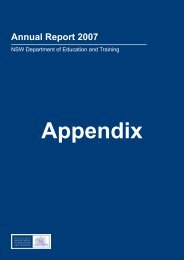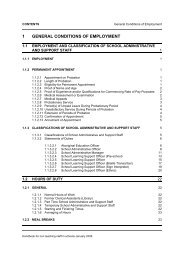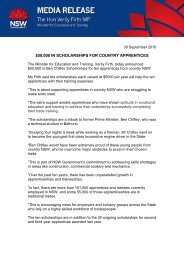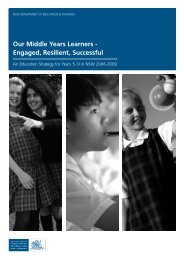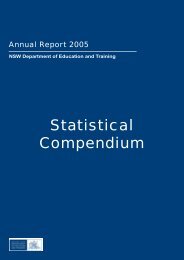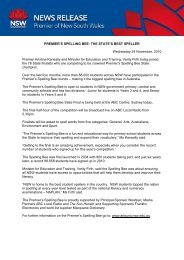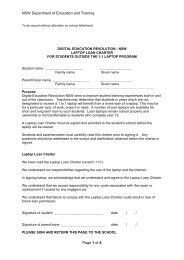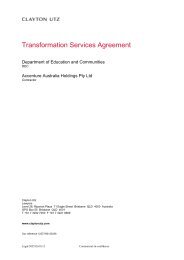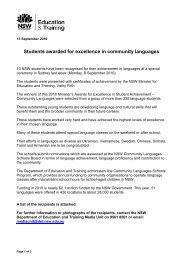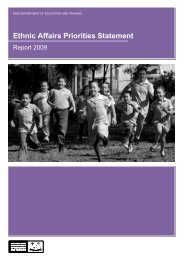Annual Report 2005 NSW Department of Education and Training
Annual Report 2005 NSW Department of Education and Training
Annual Report 2005 NSW Department of Education and Training
Create successful ePaper yourself
Turn your PDF publications into a flip-book with our unique Google optimized e-Paper software.
Appendices<br />
Appendices<br />
Appendix 22: Organisational<br />
improvement <strong>and</strong> risk management<br />
Introduction<br />
During <strong>2005</strong> the Audit Directorate developed the<br />
Enterprise Risk Management policy. This policy will<br />
be implemented in 2006, replacing the existing Risk<br />
Management Policy 91/090 (S.063, 24/4/91).<br />
The <strong>Department</strong> uses a risk management approach for<br />
both the development <strong>of</strong> its internal audit plan <strong>and</strong> for<br />
conducting audits <strong>and</strong> reviews. Staff are trained in the<br />
principles <strong>and</strong> methodology <strong>of</strong> risk management. The<br />
methodology is used to help auditors <strong>and</strong> management<br />
focus on risks relevant to the business directions <strong>of</strong> the<br />
<strong>Department</strong>.<br />
Risk assessment workshops were conducted with<br />
departmental staff for a number <strong>of</strong> audits.These<br />
workshops resulted in a shared underst<strong>and</strong>ing <strong>of</strong> risks<br />
by staff <strong>and</strong> greater acceptance <strong>and</strong> ownership <strong>of</strong><br />
recommendations made at the workshop to minimise<br />
risks <strong>and</strong> improve processes.<br />
All TAFE <strong>NSW</strong> Institutes submitted a signed statement<br />
<strong>of</strong> responsibility for internal control for <strong>2005</strong>. These<br />
documents stated that the objective <strong>of</strong> reducing risks<br />
to an acceptable level had been achieved <strong>and</strong> that a<br />
system <strong>of</strong> internal controls had operated satisfactorily.<br />
<strong>NSW</strong> government schools<br />
During <strong>2005</strong>, the <strong>Department</strong> undertook 1,305 school<br />
audits that focused on the key financial <strong>and</strong> related<br />
operations in accordance with assessed risk. These<br />
audits found that 92% <strong>of</strong> the schools managed their<br />
finances satisfactorily, while 8% had adverse reports.<br />
Common findings <strong>and</strong> summary reports were provided<br />
to regional <strong>of</strong>fices.<br />
Audits were also undertaken in school enrolments,<br />
occupational health <strong>and</strong> safety, teacher pr<strong>of</strong>essional<br />
learning <strong>and</strong> leave systems.<br />
Recommendations to improve asset management<br />
policy <strong>and</strong> procedures were implemented from 1<br />
December <strong>2005</strong>.<br />
Organisational improvement<br />
To help identify <strong>and</strong> manage risk as well as to improve<br />
processes <strong>and</strong> systems so that services to students<br />
<strong>and</strong> industry are improved, TAFE <strong>NSW</strong> Institutes,<br />
OTEN <strong>and</strong> the Centre for Learning <strong>and</strong> Innovation<br />
implemented business systems that meet ISO<br />
9001:2000 Quality St<strong>and</strong>ards. Many Institutes also<br />
embraced other improvement st<strong>and</strong>ards including<br />
ISO 14001:1996 Environmental St<strong>and</strong>ards <strong>and</strong><br />
Hazard Analyses <strong>and</strong> Critical Control Point (HACCP)<br />
St<strong>and</strong>ards.<br />
To ensure that business processes are robust, risk is<br />
identified <strong>and</strong> addressed, <strong>and</strong> internal <strong>and</strong> external<br />
audits are carried out. Findings are used to improve<br />
planning, resource use <strong>and</strong> services.<br />
TAFE <strong>NSW</strong><br />
Audits <strong>of</strong> major high-risk Institute functions such as<br />
purchasing <strong>and</strong> accounts payable, receipting <strong>and</strong><br />
banking, payroll, <strong>and</strong> occupational health <strong>and</strong> safety<br />
were conducted at all TAFE <strong>NSW</strong> Institutes. Audits<br />
were also conducted covering the International<br />
Students Centre, information <strong>and</strong> system sharing,<br />
TAFE <strong>NSW</strong> marketing, <strong>and</strong> management <strong>of</strong> staff travel.<br />
Auditors from the National Centre for Vocational<br />
<strong>Education</strong> Research (NCVER) were assisted in<br />
their audit <strong>of</strong> TAFE <strong>NSW</strong> student data on behalf <strong>of</strong><br />
the Australian National <strong>Training</strong> Authority (ANTA).<br />
This audit is considered as being <strong>of</strong> high priority as<br />
the results have a direct bearing on the Australian<br />
Government’s funding received by TAFE <strong>NSW</strong>.<br />
Statewide audit<br />
<strong>Department</strong>al staff undertook 24 audits in State Office<br />
directorates. Significant system improvements resulted<br />
from these audits <strong>and</strong> some examples are listed below.<br />
• Governance review <strong>of</strong> major DET strategic<br />
initiatives<br />
• Technology for Learning Program<br />
• Budgetary process<br />
• Joint funded projects in schools<br />
• Payroll<br />
• Accounts payable<br />
• Employment screening<br />
• Financial viability checks on higher education<br />
institutions seeking registration under the Higher<br />
<strong>Education</strong> Act<br />
• Probity audits <strong>of</strong> large tenders<br />
• Quality control review over year end accounts.<br />
Information systems<br />
Sixteen audits were completed during the year.<br />
Recommendations made in these reports, when<br />
implemented, will improve operational controls,<br />
security <strong>and</strong> efficiency in the systems reviewed.<br />
Examples <strong>of</strong> some <strong>of</strong> these audits include:<br />
• Systems - applications including corporate-wide<br />
systems (personnel, payroll, finance <strong>and</strong> student<br />
systems) <strong>and</strong> systems for specific directorates<br />
including Adult <strong>and</strong> Community <strong>Education</strong> (ACE)<br />
<strong>and</strong> Selective Schools<br />
• Infrastructure - regional networks, wide area<br />
networks, database <strong>and</strong> server management <strong>and</strong><br />
internet services<br />
• Projects - technology projects including new<br />
systems such as electronic establishment control<br />
(e-EC) upgrades, system migrations <strong>and</strong> acquisition<br />
<strong>of</strong> equipment <strong>and</strong>/or services<br />
• IT Governance - significant resources were applied<br />
to probity audits <strong>of</strong> request for tenders/quotations.<br />
DET policy documents<br />
Current DET policy documents are now accessible<br />
to staff <strong>and</strong> members <strong>of</strong> the public on the corporate<br />
111 <strong>NSW</strong> <strong>Department</strong> <strong>of</strong> <strong>Education</strong> <strong>and</strong> <strong>Training</strong> - <strong>Annual</strong> <strong>Report</strong> <strong>2005</strong>




